Startups developing microwave passive devices, a NMR-based fragment screening platform, a new way to play videogames, miniature sensors in the EVD, an handwriting iPad app for children, and radiation hard silicon carbide sensors each win CHF 10,000
30.03.2022
MinWave Technologies, NexMR, OVOMIND, Rhovica Neuroimaging, School Rebound, and SenSiC win Venture Kick's first stage of financial and entrepreneurial support. Their projects offer microwave passive devices 10 times smaller and 10 times lighter, aim to facilitate the study of challenging systems and assist biotechs in their journey to address unmet medical needs, compute biosignals from wearable devices and delivers real-time emotional data for interaction in videogames, enable a safe and fast external ventricular drain insertion that prevents devastating complications, help children improve their handwriting, and use a novel material, Silicon Carbide (SiC), and two novel technologies to fabricate and commercialize new beam monitors.
 |
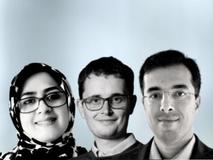 MinWave: CTO and co-founder Maliheh Khatibi, Advisor and co-founder Romain Fleury, CEO and co-founder Mostafa Khosrow
|
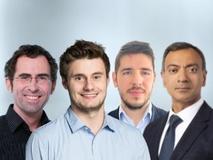 NexMR: From left to right, Scientific Advisor and co-founder Roland Riek, co-founder Matthias Buetikofer, CEO and Founder Felix Torres, Business Advisor and co-founder Anil Seth
|
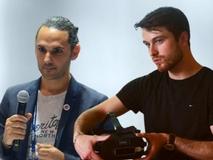 OVOMIND: CEO and Co-Founder Yann Frachi and CTO and Co-Founder Julien Masse
|
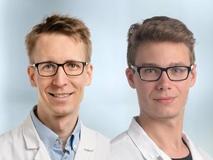 Rhovica Neuroimaging: Co-Founders Dr. med. Martin Hlavica and Dr. med. univ. Thomas Rhomberg
|
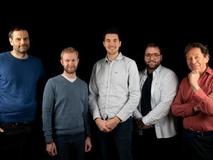 SchoolRebound, from left to right: Laurent Boatto CTO, Anthony Peguet COO, Thibault Asselborn CEO, Sven Viquerat Designer and Pierre Dillenbourg Full professor EPFL.
|
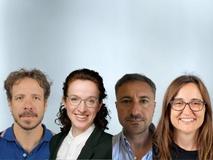 SenSiC: From Left to right CTO Massimo Camarda, CEO Judith Woerle, RD-Dosimetry Francesco Romano, RD-Sensors Mar Carulla
|
MinWave Technologies: Microwave passive devices 10x smaller, 10x lighter
Passive RF devices are parts of communication systems that lie in between the antenna and the electronics part. They exist in any communication system, such as satellite communication systems and 5g and 6g infrastructure. Given the recent demand increase in communication quality and coverage and emerging trends such as commercialized space and 5g, there is a need for more potent and cost-effective infrastructure. However, due to technical barriers, so far, the passive RF section remained bulky and massive, which increases the manufacturing and commissioning costs of communication infrastructures such as satellites. As an example in a GEO satellite, the RF payload consists of 100s to 1000s of filters that weights 10s of Kgs while the mission cost is 100s of thousands of dollars per Kg. Existing size reduction technologies come at a huge cost of energy efficiency which simply makes them unusable or costly to use in many applications.
MinWave core competency is an innovative design framework for at least 10 times smaller and lighter micro/millimeter-wave all metallic waveguide devices and fabrication of these components using additive manufacturing methods. MinWave solution can reduce the communication payload weight of a satellite by 90% while reducing the manufacturing cost. The market potential for MinWave products is estimated above 3.3 B$ which grows at a rate of 7% annually. Co-founders are CTO Dr. Khatibi, inventor of the technique, CEO Dr. Mostafa Khosrownejad, an EPFL mechanical engineering Ph.D. graduate, and scientific advisor Prof. Romain Fleury.
Receiving Venture Kick funds at this stage will help MinWave expand marketing and business development activities. minwave.ch
NexMR: NMR-based fragment screening made easy
Fragment-based drug discovery (FBDD) successfully brought over forty drugs to the clinics and four to the market. However, state-of-the-art techniques often fail to address the most challenging targets. This is due to the tedious assay development and constraining required sample conditions. Another common problem is the lack of data overlap within the orthogonal methods because experimental conditions may introduce bias. NMR would be an ideal technique but is too slow because of its low sensitivity. Moreover, current methods do not detect the best hits.
NexMR aims to deliver fully characterized hits to support drug discovery pipelines. NexMR was co-founded by CEO Felix Torres, Post-Doc at ETH Zürich, and Matthias Bütikofer currently as a Ph.D. at the group of Prof Roland Riek who helps them as a scientific advisor, and with Anil Sethi, on legal and business negotiations. Thanks to their proprietary technology using sensitivity-enhanced NMR they can screen libraries of thousands of molecules within days. They are also able to characterize the hits without idle time, as their technology encompasses affinity and structure determination. Contrary to state-of-the-art methods (X-ray crystallography, surface plasmon resonance), they only require minimal assay development, allowing them to screen challenging targets which have not been addressed so far. The sample conditions used in NMR are milder and closer to physiological conditions than for other techniques, therefore facilitating the transition to further development. NexMR is committed to supporting drug discovery with highly actionable data. Thanks to their versatile platform, they aim to facilitate the study of challenging systems and to assist biotechs in their journey to address unmet medical needs. Their target is to reach 5% of the fragment screening market in 5 years which is estimated at USD 32M turnover, with a growth of the fragment-based drug discovery market estimated at USD 1.1B.
They plan to use the Venture Kick funds first on ensuring service deliverability. This will enable them to generate initial revenue and gain experience with early customers. nexmr.com
OVOMIND: a new way to play and stream videogames
Playing with a classic game controller does not allow the gamer to truly express his personality, have experienced humanized AIs, and be immersed in a game. In 2006 Nintendo Wii introduced Motion and removed the barrier of using a classic game controller. Making gaming even more accessible. It was a huge market success, but only the first step of these emerging gaming technologies.
OVOMIND developed a Cloud-based AI affective solution including some patents. Co-founders are CEO Yann FRACHI, CTO Julien and CSO is Mathieu Barthet. The technology computes biosignals from wearable devices (smart bands and smartwatches) and delivers real-time emotional data for interaction. Emotion is the missing part of the perfect Human-Machine interaction. Gaming proposes today, the most advanced Human-Machine Interaction and OVOMIND targeting game streams first and proposes one Software Development Kit to integrate the technology on any games. They are at the MVP stage and looking to do their second seed fundraising round to push their product to the market.
The Venture Kick funds will help them to grow the business development of the company. ovomind.com
Rhovica Neuroimaging: integrating miniature sensors in the EVD
Rapid and safe placement of an external ventricular drain (EVD) is a lifesaving emergency procedure. EVDs are thin catheters, that are inserted into the brain-cavities (ventricles) for fluid-drainage to decrease intracranial pressure (ICP) and for measurement of ICP. Their insertion is one of the most frequent neurosurgical interventions with more than 35'000 insertions per year in the USA. Today, the trajectory for insertion is chosen mostly solely by superficial anatomical landmarks for saving time. This leads to high misplacement rates with the risk of devastating results due to time delay and injury of functionally important structures. Furthermore, once in place, often follow-CTs are performed, to monitor the ventricle size, with associated risks and costs.
Rhovica Neuroimaging's innovation solves these problems by integrating sensors in the catheter to localize the ventricles and allow a real-time ventricle-monitoring. This enables a safe, fast and cost-efficient EVD-placement and ventricle-monitoring with prevention of devastating complications even in most difficult cases, sparing time, reducing a high number of head-CT scans and costs. Co-Founders Dr. med. Martin Hlavica and Dr. med. univ. Thomas Rhomberg are both from the University Hospital in Bern and work in collaboration with CSEM.
The team estimates the market volume for current EVDs today in Europe and North America of around CHF 60 million per year. Additional EVD functions, as they would provide, would allow a higher price, leading to a higher market volume.
Venture Kick financing would allow them additional funding to pursue the steps on their way building up their company and would be used for the development of a working prototype in the scope of an Innosuisse Innovation Project.
School Rebound: iPad app for children's handwriting difficulties
Today 25% of kids, not even 7 years old, are already condemned to a painful school life due to their poor handwriting skills. Even worse, close to 9% of them suffer from severe difficulties, labeled ‘dysgraphia’. This impacts many other areas of school ranging from a lack of confidence, low self-esteem, difficulties in learning other skills, higher level of fatigue and stress to behavior problems in class and or at home. We miss early detection and remediation of these difficulties in order to ensure that these children follow their educational path like any other children.
To tackle this issue, School Rebound was created as a spin-off from the CHILI laboratory at EPFL. Co-founders sre CEO Thibault Asselborn, Pierre Dillenbourg, CTO Laurent Boatto Project Manager Anthony Peguet. Together with Designer Sven Viquerat, they have created the Dynamilis iPad application. Firstly, this app integrates a tool to analyze children's handwriting on many distinct aspects and extract the specific areas the child needs to focus on to improve his/her handwriting. Secondly, Dynamilis proposes different activities, in the form of games and co-created with more than 40 handwriting specialists, allowing the child to work on their specific difficulties in a fun way whether at home, with a therapist, or at school. The activities are recommended for each child according to their handwriting profile extracted during the analysis. Dynamilis comes with a monthly or annual subscription for three different segments: parents, therapists, and schools and is and is currently available in France, Switzerland and Italy.
They will use the Venture Kick funds to optimize the product to fit the market, but also to validate the pricing part of our business model and the marketing channels to be used. We will also extend the app to other languages including Spanish & Portuguese. dynamilis.com
SenSiC: radiation hard silicon carbide sensors
Currently, diamond sensors and ionization chambers are the sensor technologies of choice for synchrotrons and radiotherapies, respectively. However, they are limited regarding the maximum dimensions of their active area and transparency in the case of diamond sensors, as well as regarding their ability to measure very short and intense pulses in the case of ionization chambers.
SenSiC is addressing these challenges by employing a novel material, silicon carbide (SiC), and a novel SiC thinning technology to fabricate and commercialize new beam monitors. SiC is a wide bandgap semiconductor that is already extensively used in the power electronic market, especially for electronic vehicle applications. It combines the industrial maturity of silicon manufacturing with the mechanical, electrical, and chemical toughness comparable to diamond. SenSiC was founded by Dr. M. Camarda and is supported by his team members and technical advisors, Dr. J. Wörle, Dr. Mar Carulla and Dr. F. Romano, as well as an industrial advisor, Dr. C. Schulze-Briese, CFO of DECTRIS AG. SenSiC will be active in the beam monitoring market, mainly focusing on two distinct, but synergic applications: x-ray beam monitors for synchrotrons and electron beam sensors for radiotherapy treatments in hospitals. Real-time beam monitoring is a fast-growing business, due to increasing demands on the beam stability and efficiency of synchrotron beams and future high-dose-rates radiotherapies (FLASH).
The team plans to use the Venture Kick Funds for testing the newly developed sensors in real-life settings at various electron and proton beamlines across Europe which is a critical step towards the successful commercialization of their product.
sensic.ch
Passive RF devices are parts of communication systems that lie in between the antenna and the electronics part. They exist in any communication system, such as satellite communication systems and 5g and 6g infrastructure. Given the recent demand increase in communication quality and coverage and emerging trends such as commercialized space and 5g, there is a need for more potent and cost-effective infrastructure. However, due to technical barriers, so far, the passive RF section remained bulky and massive, which increases the manufacturing and commissioning costs of communication infrastructures such as satellites. As an example in a GEO satellite, the RF payload consists of 100s to 1000s of filters that weights 10s of Kgs while the mission cost is 100s of thousands of dollars per Kg. Existing size reduction technologies come at a huge cost of energy efficiency which simply makes them unusable or costly to use in many applications.
MinWave core competency is an innovative design framework for at least 10 times smaller and lighter micro/millimeter-wave all metallic waveguide devices and fabrication of these components using additive manufacturing methods. MinWave solution can reduce the communication payload weight of a satellite by 90% while reducing the manufacturing cost. The market potential for MinWave products is estimated above 3.3 B$ which grows at a rate of 7% annually. Co-founders are CTO Dr. Khatibi, inventor of the technique, CEO Dr. Mostafa Khosrownejad, an EPFL mechanical engineering Ph.D. graduate, and scientific advisor Prof. Romain Fleury.
Receiving Venture Kick funds at this stage will help MinWave expand marketing and business development activities. minwave.ch
NexMR: NMR-based fragment screening made easy
Fragment-based drug discovery (FBDD) successfully brought over forty drugs to the clinics and four to the market. However, state-of-the-art techniques often fail to address the most challenging targets. This is due to the tedious assay development and constraining required sample conditions. Another common problem is the lack of data overlap within the orthogonal methods because experimental conditions may introduce bias. NMR would be an ideal technique but is too slow because of its low sensitivity. Moreover, current methods do not detect the best hits.
NexMR aims to deliver fully characterized hits to support drug discovery pipelines. NexMR was co-founded by CEO Felix Torres, Post-Doc at ETH Zürich, and Matthias Bütikofer currently as a Ph.D. at the group of Prof Roland Riek who helps them as a scientific advisor, and with Anil Sethi, on legal and business negotiations. Thanks to their proprietary technology using sensitivity-enhanced NMR they can screen libraries of thousands of molecules within days. They are also able to characterize the hits without idle time, as their technology encompasses affinity and structure determination. Contrary to state-of-the-art methods (X-ray crystallography, surface plasmon resonance), they only require minimal assay development, allowing them to screen challenging targets which have not been addressed so far. The sample conditions used in NMR are milder and closer to physiological conditions than for other techniques, therefore facilitating the transition to further development. NexMR is committed to supporting drug discovery with highly actionable data. Thanks to their versatile platform, they aim to facilitate the study of challenging systems and to assist biotechs in their journey to address unmet medical needs. Their target is to reach 5% of the fragment screening market in 5 years which is estimated at USD 32M turnover, with a growth of the fragment-based drug discovery market estimated at USD 1.1B.
They plan to use the Venture Kick funds first on ensuring service deliverability. This will enable them to generate initial revenue and gain experience with early customers. nexmr.com
OVOMIND: a new way to play and stream videogames
Playing with a classic game controller does not allow the gamer to truly express his personality, have experienced humanized AIs, and be immersed in a game. In 2006 Nintendo Wii introduced Motion and removed the barrier of using a classic game controller. Making gaming even more accessible. It was a huge market success, but only the first step of these emerging gaming technologies.
OVOMIND developed a Cloud-based AI affective solution including some patents. Co-founders are CEO Yann FRACHI, CTO Julien and CSO is Mathieu Barthet. The technology computes biosignals from wearable devices (smart bands and smartwatches) and delivers real-time emotional data for interaction. Emotion is the missing part of the perfect Human-Machine interaction. Gaming proposes today, the most advanced Human-Machine Interaction and OVOMIND targeting game streams first and proposes one Software Development Kit to integrate the technology on any games. They are at the MVP stage and looking to do their second seed fundraising round to push their product to the market.
The Venture Kick funds will help them to grow the business development of the company. ovomind.com
Rhovica Neuroimaging: integrating miniature sensors in the EVD
Rapid and safe placement of an external ventricular drain (EVD) is a lifesaving emergency procedure. EVDs are thin catheters, that are inserted into the brain-cavities (ventricles) for fluid-drainage to decrease intracranial pressure (ICP) and for measurement of ICP. Their insertion is one of the most frequent neurosurgical interventions with more than 35'000 insertions per year in the USA. Today, the trajectory for insertion is chosen mostly solely by superficial anatomical landmarks for saving time. This leads to high misplacement rates with the risk of devastating results due to time delay and injury of functionally important structures. Furthermore, once in place, often follow-CTs are performed, to monitor the ventricle size, with associated risks and costs.
Rhovica Neuroimaging's innovation solves these problems by integrating sensors in the catheter to localize the ventricles and allow a real-time ventricle-monitoring. This enables a safe, fast and cost-efficient EVD-placement and ventricle-monitoring with prevention of devastating complications even in most difficult cases, sparing time, reducing a high number of head-CT scans and costs. Co-Founders Dr. med. Martin Hlavica and Dr. med. univ. Thomas Rhomberg are both from the University Hospital in Bern and work in collaboration with CSEM.
The team estimates the market volume for current EVDs today in Europe and North America of around CHF 60 million per year. Additional EVD functions, as they would provide, would allow a higher price, leading to a higher market volume.
Venture Kick financing would allow them additional funding to pursue the steps on their way building up their company and would be used for the development of a working prototype in the scope of an Innosuisse Innovation Project.
School Rebound: iPad app for children's handwriting difficulties
Today 25% of kids, not even 7 years old, are already condemned to a painful school life due to their poor handwriting skills. Even worse, close to 9% of them suffer from severe difficulties, labeled ‘dysgraphia’. This impacts many other areas of school ranging from a lack of confidence, low self-esteem, difficulties in learning other skills, higher level of fatigue and stress to behavior problems in class and or at home. We miss early detection and remediation of these difficulties in order to ensure that these children follow their educational path like any other children.
To tackle this issue, School Rebound was created as a spin-off from the CHILI laboratory at EPFL. Co-founders sre CEO Thibault Asselborn, Pierre Dillenbourg, CTO Laurent Boatto Project Manager Anthony Peguet. Together with Designer Sven Viquerat, they have created the Dynamilis iPad application. Firstly, this app integrates a tool to analyze children's handwriting on many distinct aspects and extract the specific areas the child needs to focus on to improve his/her handwriting. Secondly, Dynamilis proposes different activities, in the form of games and co-created with more than 40 handwriting specialists, allowing the child to work on their specific difficulties in a fun way whether at home, with a therapist, or at school. The activities are recommended for each child according to their handwriting profile extracted during the analysis. Dynamilis comes with a monthly or annual subscription for three different segments: parents, therapists, and schools and is and is currently available in France, Switzerland and Italy.
They will use the Venture Kick funds to optimize the product to fit the market, but also to validate the pricing part of our business model and the marketing channels to be used. We will also extend the app to other languages including Spanish & Portuguese. dynamilis.com
SenSiC: radiation hard silicon carbide sensors
Currently, diamond sensors and ionization chambers are the sensor technologies of choice for synchrotrons and radiotherapies, respectively. However, they are limited regarding the maximum dimensions of their active area and transparency in the case of diamond sensors, as well as regarding their ability to measure very short and intense pulses in the case of ionization chambers.
SenSiC is addressing these challenges by employing a novel material, silicon carbide (SiC), and a novel SiC thinning technology to fabricate and commercialize new beam monitors. SiC is a wide bandgap semiconductor that is already extensively used in the power electronic market, especially for electronic vehicle applications. It combines the industrial maturity of silicon manufacturing with the mechanical, electrical, and chemical toughness comparable to diamond. SenSiC was founded by Dr. M. Camarda and is supported by his team members and technical advisors, Dr. J. Wörle, Dr. Mar Carulla and Dr. F. Romano, as well as an industrial advisor, Dr. C. Schulze-Briese, CFO of DECTRIS AG. SenSiC will be active in the beam monitoring market, mainly focusing on two distinct, but synergic applications: x-ray beam monitors for synchrotrons and electron beam sensors for radiotherapy treatments in hospitals. Real-time beam monitoring is a fast-growing business, due to increasing demands on the beam stability and efficiency of synchrotron beams and future high-dose-rates radiotherapies (FLASH).
The team plans to use the Venture Kick Funds for testing the newly developed sensors in real-life settings at various electron and proton beamlines across Europe which is a critical step towards the successful commercialization of their product.
sensic.ch


